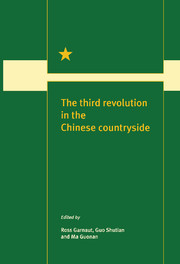Book contents
- Frontmatter
- Contents
- Figures
- Maps
- Tables
- Contributors
- Preface
- 1 The third revolution
- Feeding the people
- Marketing and price reform
- Internationalisation
- Regional issues
- 15 The grain economy of Guangdong: internationalisation or East Asian style protectionism?
- 16 Grain production and regional economic change
- 17 Regional inequality in rural development
- Institutional change
- References
- Index
15 - The grain economy of Guangdong: internationalisation or East Asian style protectionism?
from Regional issues
Published online by Cambridge University Press: 04 August 2010
- Frontmatter
- Contents
- Figures
- Maps
- Tables
- Contributors
- Preface
- 1 The third revolution
- Feeding the people
- Marketing and price reform
- Internationalisation
- Regional issues
- 15 The grain economy of Guangdong: internationalisation or East Asian style protectionism?
- 16 Grain production and regional economic change
- 17 Regional inequality in rural development
- Institutional change
- References
- Index
Summary
China is the largest grain consumer and producer in the world. It has 22 per cent of the world's population and produces 21 per cent of the world's cereal output. China is also the largest trading nation in the world grain market. Between 1985 and 1991 China's wheat imports averaged 13 per cent of the world's total traded volumes. The future direction of China's grain demand, supply and trade will have a profound influence on the international grain market.
The early liberalisation of the grain sector led to large increases in the volume of production, but was not problem free (Sicular 1988a). Guangdong province has been in the vanguard of China's reforms and open policies, including in agriculture. Guangdong's experiences in the past decade have served as something of a testing ground and inspiration for economy-wide reform (Lardy 1992a; Vogel 1989). It was among the first provinces to undertake major reforms on vegetable, fish, pork, grain and edible oil prices. Market forces have a much greater role in Guangdong's economy than elsewhere in China.
Guangdong is among the four highest-income provinces, although not yet the highest, and the fifth most populous province. It is by far the largest provincial economy in terms of GDP, and the nation's largest exporter. It is only eclipsed in openness and rate of growth by the small island province of Hainan, which was separated from Guangdong in 1987.
- Type
- Chapter
- Information
- The Third Revolution in the Chinese Countryside , pp. 200 - 217Publisher: Cambridge University PressPrint publication year: 1996



